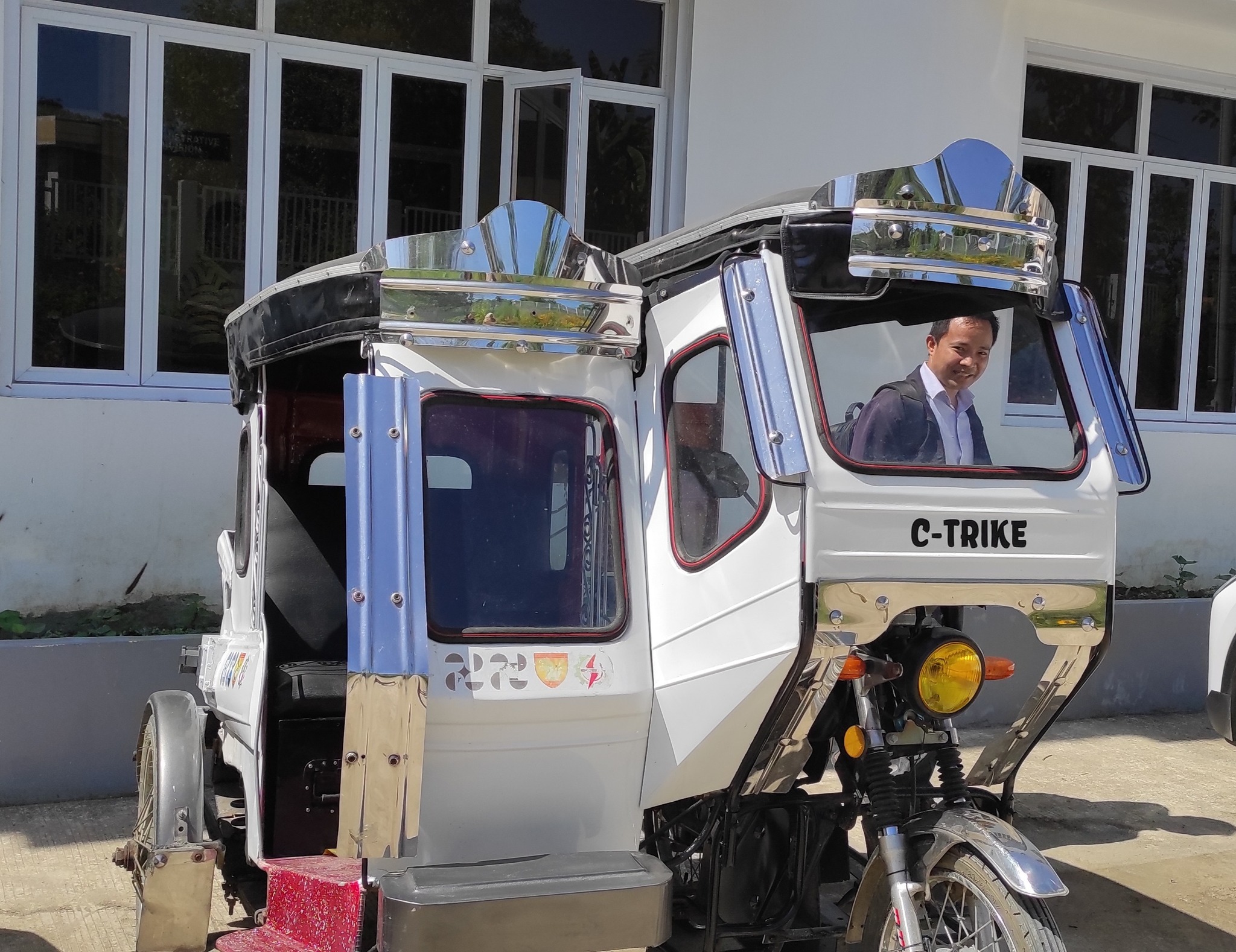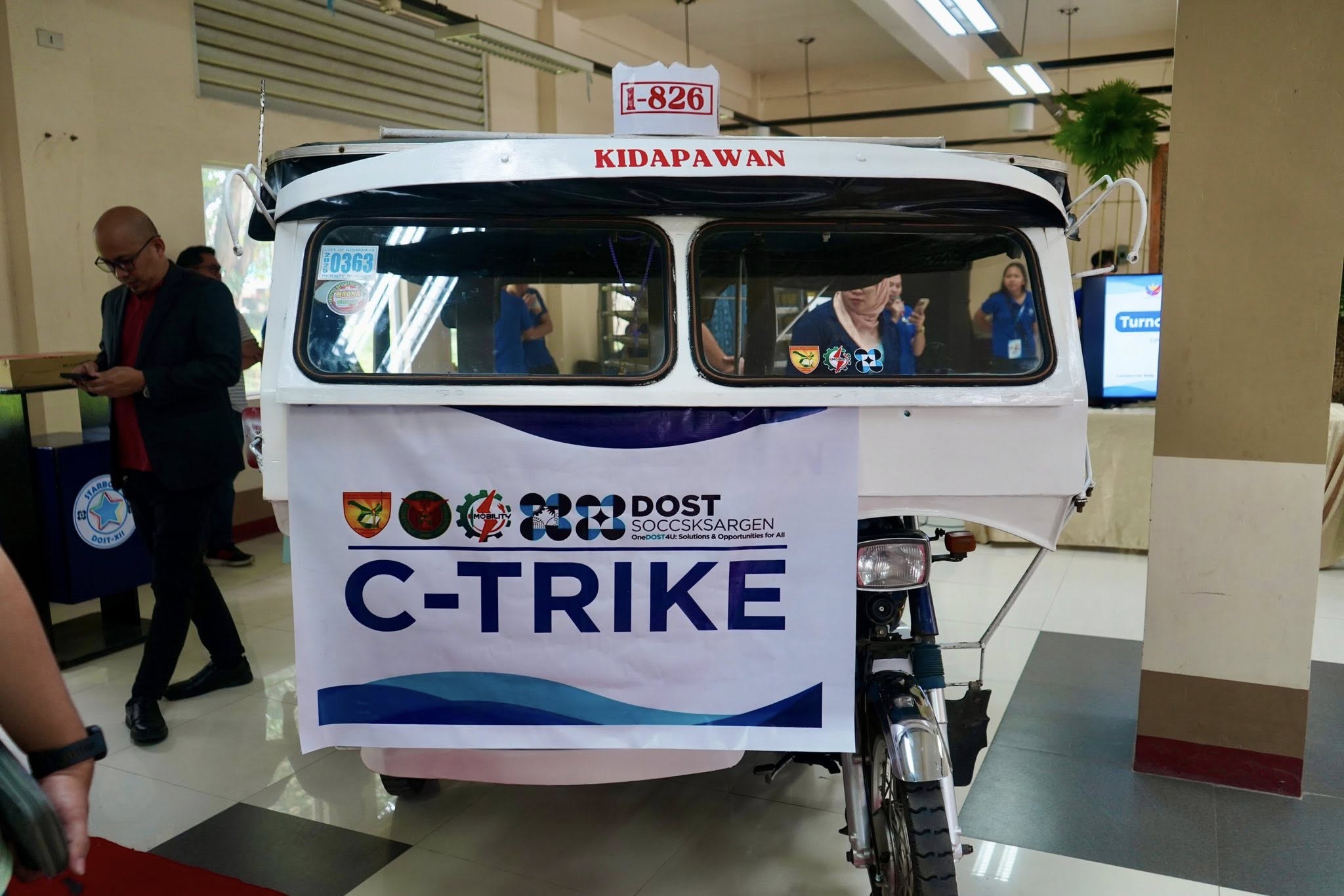Support CleanTechnica’s work through a Substack subscription or on Stripe.
Conversion, the kind that doesn’t involve swapping religions or political affiliations, is a practice well known in the Philippines.
The most famous, so far, is converting vehicles from right-hand drive to left-hand drive. This kind of conversion, looked upon with disdain and sometimes fright by engineers, has given the Filipinos Japan’s discarded kei cars and heavy trucks to operate and maintain, and on the sad, unwanted occasion, perish in.
Thus, the Cagayan State University (CSU) C-Trike (Converted Electric Tricycle) displayed at this weekend’s 2025 National Science and Technology Week (NSTW) in the very northern city of Laoag, Ilocos Norte, impressed because it sent one important message: conversion isn’t bad, it rids the ubiquitous Philippine tricycle of the original smoke-spewing, two-stroke engine and transforms it into a fully electric, zero-emission vehicle.
The C-Trike, developed through CSU’s ElectroMobility Research and Development Center (EMRDC), represents years of research and collaboration between the Department of Science and Technology’s (DOST) Philippine Council for Industry, Energy and Emerging Technology Research and Development (PCIEERD), DOST Region 2, and the University of the Philippines Diliman.
With P79.4 million (approximately $1.4 million) in total project funding, the C-Trike forms part of DOST’s Smart and Sustainable Communities Program (SSCP), a national initiative advancing eco-friendly mobility solutions.
From concept to almost-commercialization
The C-Trike isn’t new. The concept goes way back to 2021 through DOST-funded studies examining e-trike viability.
Initial research comparing ten market-ready e-trikes against traditional 2-stroke and 4-stroke tricycles demonstrated that electric vehicles could travel up to 80,000 kilometers, accommodate maximum road loads, and utilize significantly less energy than their gasoline-powered counterparts.
These findings became the springboard for establishing the ElectroMobility Research and Development Center at CSU, led by program leader Engineer Arthur Ibanez, with Engineers Audy Quebral and Michael Orpilla serving as CSU project leaders for the e-trike and C-trike projects respectively.
During the 2023 National Science and Technology Week celebration in Iloilo City, CSU exhibited both its revolutionary e-trike and the newly developed C-trike. The vehicles were created under CSU’s first NICER (Niche Centers in the Regions for Research and Development) program titled “Electromobility Research and Development Center.”
DOST Region 2, CSU, and the Central Isabela Agri Manufacturing Corp. (CIAMC) signed a Technology Licensing Agreement establishing terms and conditions for e-trike commercialization. DOST Region 2 Director Virginia Bilgera characterized the agreement as a response to mounting environmental concerns and escalating living costs.
The agreement covered the e-trike’s project design, development, fabrication of different parts, and assembly procedures.
The e-trike technology took center stage at the 2024 Regional Science, Technology, and Innovation Week (RSTW) in Cagayan Valley on September 25, 2024, at SM City Tuguegarao. During a press conference at CSU’s Carig Campus, DOST Secretary Renato Solidum, along with CSU representatives, partner agencies, researchers, and industry experts, signed Technology Licensing Agreements and Memoranda of Agreement (MOA) on e-trike technology. Secretary Solidum emphasized that science and technology serve as pathways to progress and solutions to real-world problems, not merely tools for discovery.
The event also marked the formal inauguration of the Electromobility Research and Development Center (EMRDC), with the e-mobility project divided into three phases. The first two phases focused on development and production, successfully converting two traditional tricycles into e-trikes after completing viability studies.

Made in Mindanao
The C-Trike featured prominently at the HANDA Pilipinas Mindanao Leg and RSTW 2025, hosted by DOST Region IX on September 23–25, 2025. DOST Secretary Solidum and Undersecretary for Regional Operations Engr. Sancho A. Mabborang emphasized that preparedness represents a lifeline rather than a luxury, highlighting how science-driven innovations like the C-Trike strengthen community resilience. The event also saw the inauguration of DOST Region IX’s first Advanced Manufacturing Center (AMCEN) at Western Mindanao State University.
Throughout 2025, CSU and DOST conducted exhibitions showcasing e-trikes in multiple provinces, including Batanes, Nueva Vizcaya, Isabela, Apayao, Quirino, Kalinga, and Iloilo, with expansion plans to Mindanao encompassing General Santos City, Bukidnon, Zamboanga, and Basilan. By March 2025, CSU had secured four technology adopters—two from Isabela, one from Cebu, and one from Pasay City.
The C-Trike’s appearance at the 2025 National Science and Technology Week in Laoag City represented a culmination of years of development. The week-long event featured activities, forums, and interactive exhibits anchored on the sub-theme “Building Smart and Sustainable Communities,” showcasing R&D-based and scientific services offering long-term solutions to communities’ pressing challenges.
Earlier in 2025, CSU’s EMRDC received the Excellence in Project Implementation and Completion (EPIC) Award from DOST-PCIEERD in recognition of its timely, efficient, and goal-oriented execution of its e-trike projects.
Technical specifications and performance
The C-Trike offers impressive performance metrics that position it as a viable alternative to gasoline-powered tricycles. The vehicle can travel up to 80 kilometers on a single charge, making it ideal for daily urban routes. In collaboration with UP Diliman, CSU developed a fast-charging battery capable of fully charging in just 35 minutes—a significant improvement over traditional electric vehicle charging times of 8 to 12 hours.
The research team is also developing a battery-swapping system that would allow drivers to replace batteries as quickly as refueling a gasoline-powered vehicle. This innovation addresses one of the key barriers to light electric vehicle (LEV) adoption in the Philippines, as batteries currently account for 40–60 percent of the total vehicle cost. The battery standardization project, led by Engineer Mark Anthony S. Ibañez, has received P8 million in funding from DOST-PCIEERD.
The economic advantages of the C-Trike are substantial. Research shows the vehicle costs only P0.88 (approximately $0.015) per kilometer to operate, compared to P3.20 for 2-stroke engines and P2.30 for 4-stroke tricycles. This dramatic reduction in operating costs translates to significantly increased take-home income for tricycle drivers, making the technology both environmentally responsible and economically attractive.
For context, Tuguegarao City alone has over 7,000 franchised tricycles, plus thousands more unregistered vehicles. Most run on 2-stroke or 4-stroke engines that contribute significantly to air pollution. The C-Trike’s conversion process replaces the traditional mechanical engine with an electric power system, eliminating harmful emissions while offering substantial savings.
If widespread adoption occurs, the transportation sector could achieve the global goal of cutting carbon emissions by 75% by 2030. The e-trike’s capacity to emit less carbon dioxide would be beneficial in reducing pollution-related illnesses and improving air quality in urban centers.
The uphill ride to commercialization
To accelerate commercialization and community deployment, CSU has signed Technology Licensing Agreements with ACT Machineries and Metal Craft Corporation and Suki Trading Corporation, opening opportunities for mass production and rollout to localities seeking sustainable transport alternatives.
Initial dialogues with the Federation of Tricycle Operators and Drivers Association (FETODA) have begun, with stakeholders anticipating the enactment of local ordinances to regulate the use of converted electric tricycles. According to CSU Campus Research Coordinator Michael Orpilla, discussions in Tuguegarao City are awaiting local legislation that will govern converted electric tricycle operations.
Arnold Kein T. Tolbe of CSU’s Electromobility R&D Center reports that public reception has been overwhelmingly positive, particularly in areas where the technology has been showcased. The project is currently focused on improving charging efficiency through ongoing research into battery swapping and establishing charging and battery-swapping stations to reduce battery size and lower overall e-trike costs.
The C-Trike initiative underscores CSU’s commitment to future-ready innovations and elevates the university as a leading catalyst in advancing science-driven, environmentally responsible solutions. As Michael Orpilla noted, CSU is not merely teaching change but actively shaping it.
The project demonstrates how regional institutions can collaborate with government agencies and private industry to develop locally relevant solutions to global challenges. With its first DOST-funded Electromobility Research and Development Center for e-trike technology, CSU has established a model that other Philippine universities and research institutions can emulate.
*This story was developed from reports and coverage by Ysabelle Bianca Fernandez.

Sign up for CleanTechnica’s Weekly Substack for Zach and Scott’s in-depth analyses and high level summaries, sign up for our daily newsletter, and follow us on Google News!
Have a tip for CleanTechnica? Want to advertise? Want to suggest a guest for our CleanTech Talk podcast? Contact us here.
Sign up for our daily newsletter for 15 new cleantech stories a day. Or sign up for our weekly one on top stories of the week if daily is too frequent.
CleanTechnica uses affiliate links. See our policy here.
CleanTechnica’s Comment Policy


@2x.jpg)
